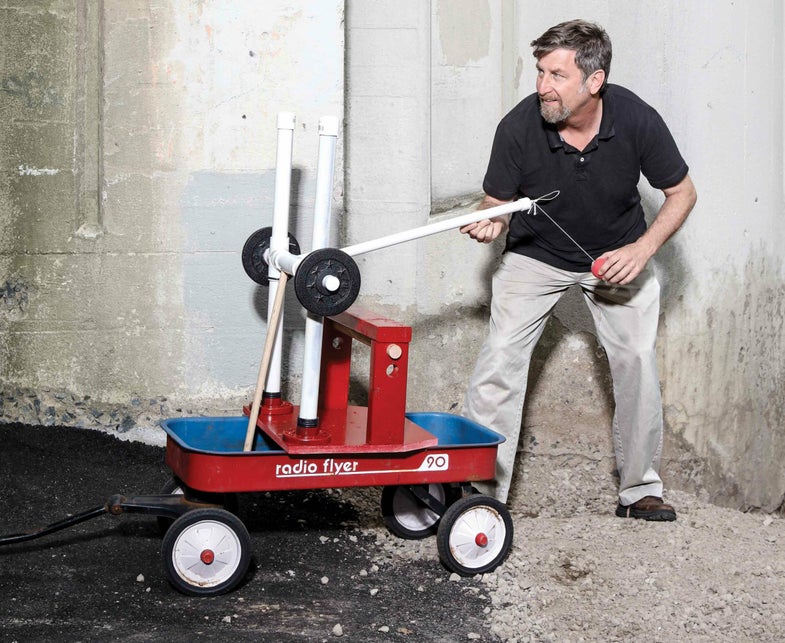Build Your Own Mini Medieval Siege Weapon
A tiny version of one of history's most powerful trebuchets

Around the turn of the 14th century, England’s King Edward I led his soldiers north to battle Scottish rebels. Eventually, he cornered his foes at Stirling Castle in central Scotland. Outside the castle walls, his English engineers built a phalanx of huge trebuchets. A trebuchet uses the force of gravity to fling projectiles. Its power comes from a counterweight—often a box that’s filled with stones or sand—connected to a lever arm. The other end of the arm is attached to a sling that holds a missile, such as a large rock. By raising the counterweight into the air with a pulley system and then letting it drop, the lever sends the boulder flying with great precision.
Edward’s trebuchets, perhaps the most powerful ones ever made, even had their own names, such as the Forester and the Vicar. The biggest was erected last. Called Ludgar, also known as Warwolf, it had enough power to fling 300-pound projectiles. By the time it was completed—four months after the siege began—the Scots were ready to surrender. But Edward was eager to test his new weapon. Unwilling to waste the time and effort spent on his deadly toy, Edward ordered the Scots back inside the castle and continued the siege. With its first toss, Ludgar broke down an entire 12-foot-thick castle wall, according to 14th-century chronicler Peter Langtoft. By the time Edward was ready to accept surrender, only 50 of the castle’s 120 defenders remained to crawl out of the rubble.
Inspired by Ludgar, I decided to make my own trebuchet. For this miniature version, I built a framework of plastic piping mounted on a stable wooden base. For a counterweight, I repurposed a pair of 5-pound barbells. A wood prop holds the weights in place and also acts as a trigger: When I pull it out of the trebuchet, the weights slide down a pair of guide rails, causing the throwing arm to flip from one side of the trebuchet to the other.
To throw a projectile—a golf ball or small water balloon—I attach a string to my missile, tie a loop in the other end, and slip the loop over the trebuchet’s arm. When the arm flips, it hurls the projectile high and far—toward an imaginary castle.
How To Build A Model Trebuchet
A counterweight-powered catapult, or trebuchet, is a fairly straightforward machine. I made mine from PVC pipe screwed onto a wooden base. PVC isn’t a particularly strong material, but if you don’t go overboard with the amount of weight, it gets the job done. To build your own, use the assembly diagram and list of instructions below.
WARNING: Always wear safety glasses in case a pipe breaks, and keep all parts of your body away from the falling weights and fast-moving throwing arm.

Trebuchet Assembly Diagram
INSTRUCTIONS:
- First, modify the 1.25-inch PVC crosses so they slide easily down the 1.25-inch PVC vertical pipes. In addition, you’ll have to modify the 1.25-inch PVC T-fitting so it rotates freely on the falling cross arm. To do this, use a rotary tool such as a Dremel with a sanding drum or better, an electric spindle sander to remove enough PVC from the interior of the crosses and T so the pipe slides through it easily. Sanding down the PVC isn’t hard, but it is a messy job, so wear a dust mask while you work.
- Once all the PVC pipe pieces are cut and the crosses are modified so they slide easily, attach the pipe flanges to the plywood base securely using screws or bolts. Then, dry fit all the pipe and pipe fixtures to make sure they fit correctly, adjusting the alignment of the PVC fittings as necessary for smooth operation.
- When all the pieces are perfectly aligned and slide easily, permanently assemble your trebuchet by solvent-welding the parts together, as shown in the assembly diagram, using PVC primer and cement.
- Next, build the wooden strike bar and attach it to the plywood base using deck screws. This is merely a wooden bar that flips the throwing arm over when it falls. You can experiment with the positioning of the strike bar for best performance.
- To get the most distance from your trebuchet, put your projectile in a sling. That increases the length of the lever arm and gives you more throwing power. While medieval catapults used a sling attached to the throwing arm, getting those to work properly is tricky, so it’s easier to simply attach the sling to the projectile. You can try golf balls, small water balloons, or other items of your own choosing for ammunition.
- To unleash the power of your machine, raise the weighted crossbar and insert a wooden prop to hold it. Tie a rope to the prop. To fire, give it a tug.
This article was originally published in the September/October 2016 issue of Popular Science, under the title “A Mini Medieval Siege Weapon.”